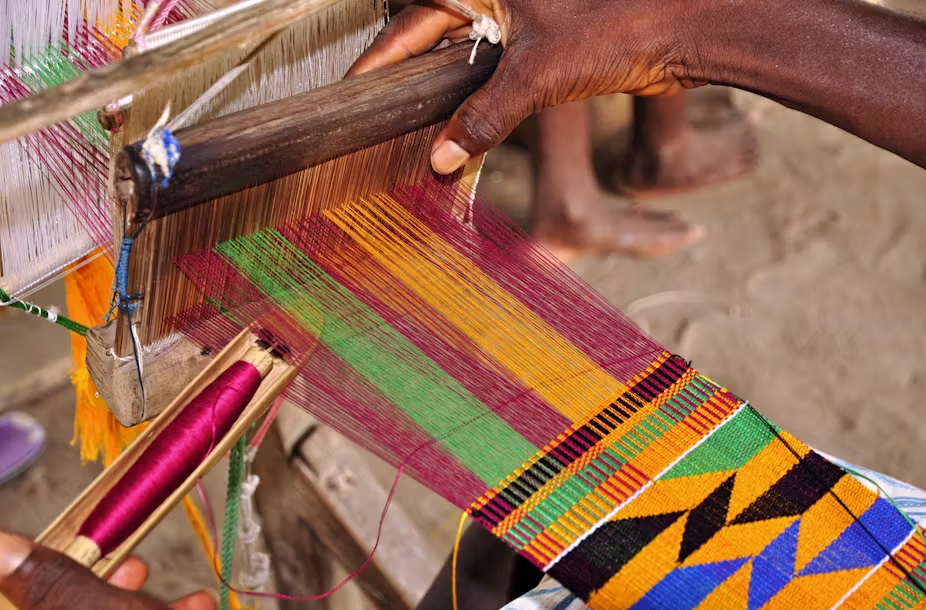
Traditional Kente weaving, rich in color and symbolism, preserves Ghana’s heritage, telling stories of identity, pride, and history.
Traditional Kente Cloth Weaving: Preserving Ghana’s Woven Heritage
Traditional Kente cloth, with its dazzling colors and intricate patterns, remains one of Ghana’s most cherished cultural symbols. Woven with care, skill, and deep cultural meaning, Kente is more than just fabric—it is a visual language that carries the identity, history, and pride of the Ghanaian people. From its origins in the Ashanti and Ewe communities to its modern global recognition, the art of Kente weaving continues to reflect a heritage that is both timeless and evolving.
Origins of Kente Weaving
Kente weaving has roots in Ghana’s Ashanti Kingdom, where it is believed that two friends, Ota Karaban and Kwaku Ameyaw, first learned the craft by observing how a spider wove its web. Inspired by this natural artistry, they developed a weaving technique that has since become a cornerstone of Ghanaian tradition. The practice also flourished among the Ewe people, who developed their own distinctive styles and motifs.
Traditionally, Kente was reserved for royalty, chiefs, and important ceremonies. The cloth represented prestige, cultural identity, and authority. Each strip of woven fabric was carefully designed to tell a story, whether about the wearer’s lineage, societal role, or aspirations.
The Weaving Process
Creating Kente is a labor-intensive process that requires both patience and artistry. The cloth is woven on a loom, with each strip measuring about four inches wide. Multiple strips are then sewn together to form the larger cloth.
The process begins with spinning and dyeing threads, often in bold and vibrant colors such as red, yellow, blue, green, and black. Each color has symbolic meaning:
- Gold/Yellow represents royalty and wealth.
- Red signifies political and spiritual power.
- Green symbolizes growth and renewal.
- Black stands for maturity and ancestral heritage.
The weaver then carefully combines these colors into patterns known as motifs, each of which has a name and cultural significance. Some motifs may highlight proverbs, honor historical events, or convey messages of unity, courage, or wisdom. For example, the pattern “Emaa Da” translates to “something that has not happened before,” celebrating uniqueness and innovation.
Cultural Significance
Kente cloth is not simply worn as clothing; it carries stories and meaning. During festivals, marriages, funerals, and naming ceremonies, individuals wear specific Kente designs to reflect the significance of the occasion. Chiefs and elders often wear Kente to symbolize their authority and to communicate values of leadership and unity.
Even today, Kente remains a garment of pride. Ghanaians at home and abroad wear it during special events, graduations, and state ceremonies, showing the enduring value of tradition in contemporary life.
Evolution and Global Appeal
While Kente weaving continues in its traditional form, the cloth has also found global recognition. Designers and fashion houses across the world now incorporate Kente patterns into modern attire, from gowns and suits to accessories. This global exposure has turned Kente into a symbol of African identity and pride, especially within the diaspora.
However, this rise in popularity also comes with challenges. Machine-made Kente imitations are widely sold, often undermining the painstaking handwoven tradition. For master weavers in towns such as Bonwire (Ashanti Region) and Agotime Kpetoe (Volta Region), this creates competition that threatens the sustainability of their craft. Efforts are being made to protect and preserve authentic Kente weaving as both a cultural and economic resource for Ghana.
Preserving the Craft for Future Generations
To sustain Kente weaving, communities, schools, and cultural institutions have introduced programs to teach young people the art of the loom. Festivals such as the Agotime Kente Festival celebrate the craft, encouraging pride and ensuring that the heritage is passed on. By combining traditional techniques with modern innovations, Ghanaian weavers are ensuring that Kente remains both relevant and respected.
Conclusion
Traditional Kente cloth weaving is a testament to Ghana’s artistry, heritage, and resilience. It is a fabric that tells stories, honors ancestors, and carries the wisdom of generations. More than just a cloth, Kente is a cultural treasure that weaves together the past, present, and future of Ghana.
RECOMMENDED ARTICLES
- Founder’s Day: Honoring Nkrumah’s Legacy
- Akan Day Names: Identity in Every Birth
- Dr. J.B. Danquah: Ghana’s Freedom Fighter
- Damba Festival: Celebrating Northern Ghana’s Rich Cultural Heritage
USEFUL LINKS
